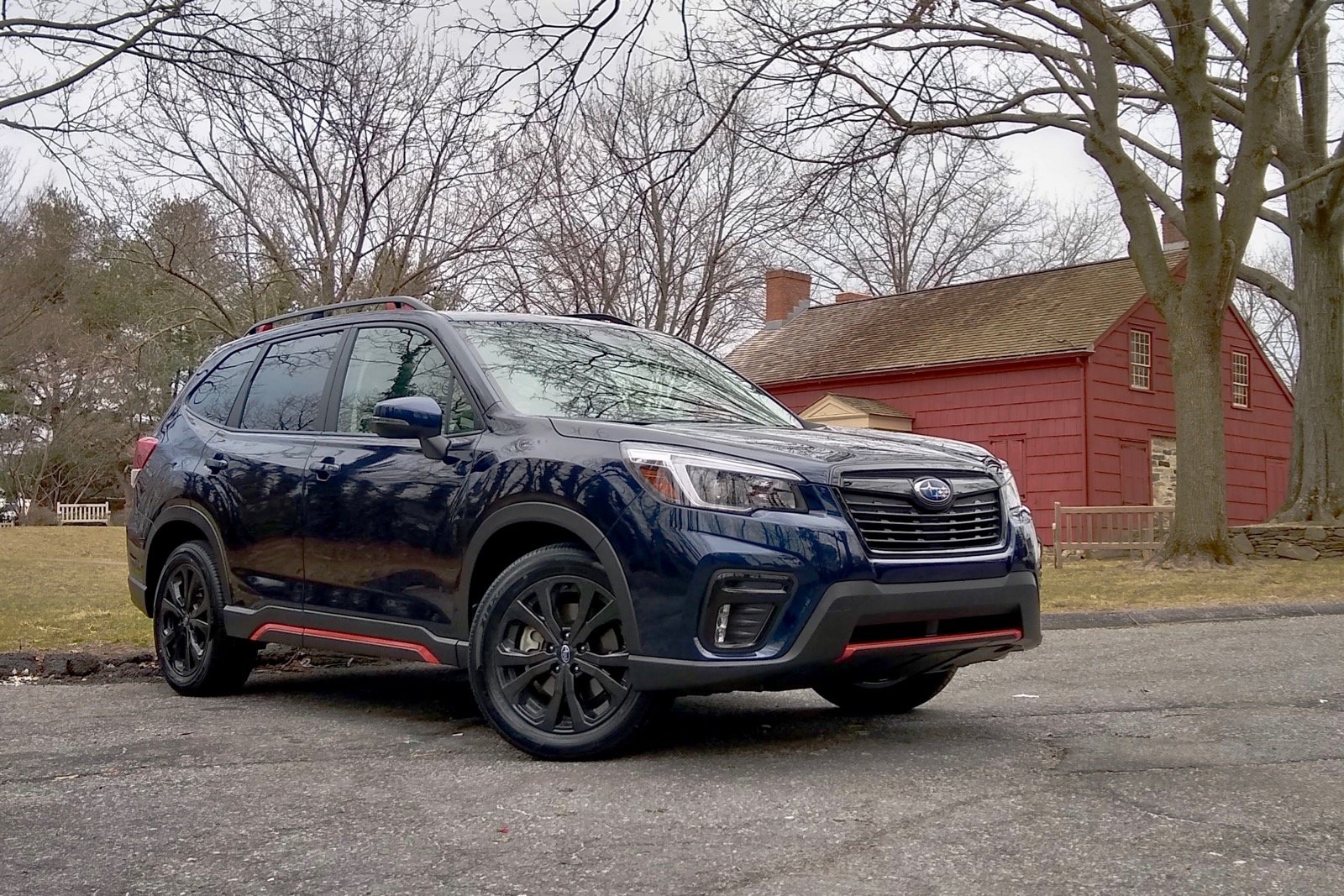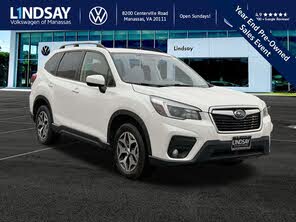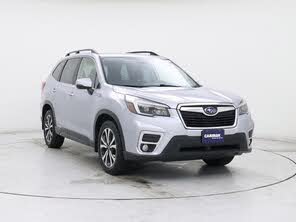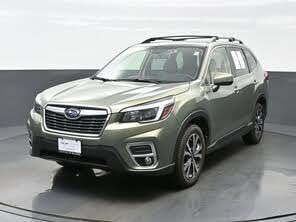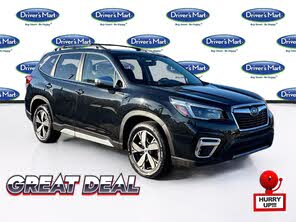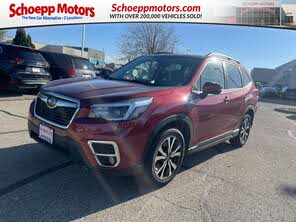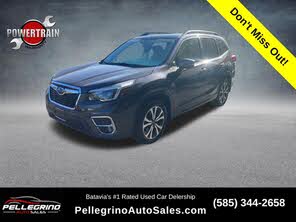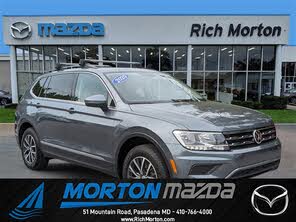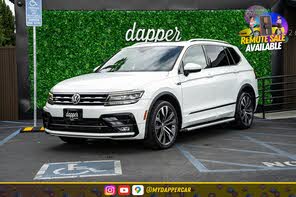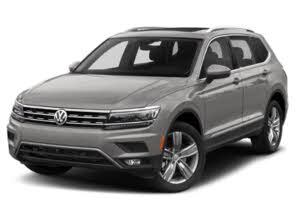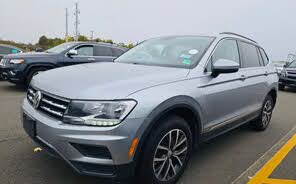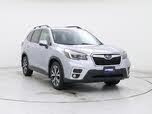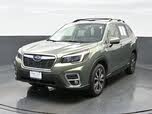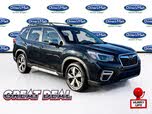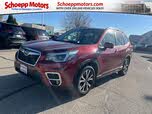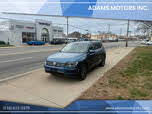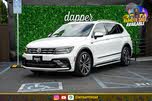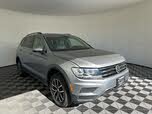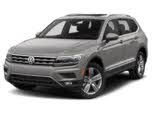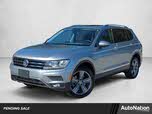2021 Subaru Forester vs 2020 Volkswagen Tiguan
Overview | |
MSRP$24,945 | MSRP$24,795 |
Listings914 | Listings1012 |
Ratings & Reviews | |
User Reviews | User Reviews |
Expert reviews7.7 out of 10 | Expert reviews7.5 out of 10 |
Pros
Cons
| Pros
Cons
|
2020 Volkswagen Tiguan Reviews SummaryThe Volkswagen Tiguan is one of only two compact crossover SUV’s that currently offer third-row seating. (And the other is the hopelessly outdated Mitsubishi Outlander.) To fit the extra pair of surprisingly spacious seats, VW made the Tiguan much larger than average for its competitive set—which suits a vehicle that fills big shoes in VW dealerships. With five trim levels and prices that stretch from just under $26,000 to a bit over $40,000, the Tiguan is the German brand’s best-selling vehicle in the U.S. | |
2021 Subaru Forester Reviews SummaryThe Subaru Forester was one of the original compact crossover SUVs. Along with the Ford Escape, Honda CR-V, and Toyota RAV4, it helped introduce a vehicular genre that is now displacing traditional sedans from American driveways. That means the Forester has more competition than ever. What was once a small market segment has swelled with the addition of compact SUVs like the Hyundai Tucson, Kia Sportage, Mazda CX-5, Nissan Rogue, Volkswagen Tiguan, and the modern version of the Jeep Cherokee. To keep pace with the competition, the Forester has packed on technology—and pounds. While the first-generation Forester (affectionately nicknamed “toaster” by fans because of its boxy shape) was genuinely compact, the current version has the footprint of a midsize SUV from two decades ago. This version was introduced for the 2019 model year, so it doesn’t change much for 2021. The only news is the addition of three standard safety features—steering-responsive LED headlights, automatic high beams, and a rear seatbelt reminder—standard fog lights and keyless access with push-button start for the Premium trim level, and additional equipment reshuffling on other trim levels. The 2021 Subaru Forester is available in five trim levels—Base, Premium, Sport, Limited, and Touring—all with standard all-wheel drive (AWD). Our test car was the mid-range Sport model. | |
No video found | |
Popular Features & Specs | |
Engine2.0L 184 hp I4 | Engine2.5L 182 hp H4 |
Drive TrainFWD | Drive TrainAWD |
Seating Capacity7 | Seating Capacity5 |
Horsepower184 hp @ 4400 rpm | Horsepower182 hp @ 5800 rpm |
MPG City22 | MPG City26 |
MPG Highway29 | MPG Highway33 |
Engine | |
Engine Name2.0L 184 hp I4 | Engine Name2.5L 182 hp H4 |
Torque221 lb-ft @ 1600 rpm | Torque178 lb-ft @ 4400 rpm |
Horsepower184 hp @ 4400 rpm | Horsepower182 hp @ 5800 rpm |
DrivetrainFWD | DrivetrainAWD |
Fuel Economy | |
MPG City22 | MPG City26 |
MPG Highway29 | MPG Highway33 |
Interior | |
Seating Capacity7 | Seating Capacity5 |
Safety | |
Front Crash Overall4 | Front Crash Overall5 |
Side Crash Overall5 | Side Crash Overall5 |
Dimensions & Capacity | |
Cargo Space12.0 cu ft | Cargo Space31.1 cu ft |
Curb Weight3757 lbs | Curb Weight3453 lbs |
Height66.3 in | Height67.5 in |
Length185.1 in | Length182.1 in |
Width72.4 in | Width80.9 in |
Wheelbase109.8 in | Wheelbase105.1 in |
Maximum Payload1124 lbs | Maximum Payload1438 lbs |
Number of doors4 | Number of doors4 |
Maximum Towing Capacity1500 lbs | Maximum Towing Capacity1500 lbs |
Overview | ||
MSRP | $24,945 | $24,795 |
Listings | ||
Ratings & Reviews | ||
User reviews | ||
Expert reviews | 7.7 out of 10Read full review | 7.5 out of 10Read full review |
Pros & cons | Pros
Cons
| Pros
Cons
|
Summary | The Volkswagen Tiguan is one of only two compact crossover SUV’s that currently offer third-row seating. (And the other is the hopelessly outdated Mitsubishi Outlander.) To fit the extra pair of surprisingly spacious seats, VW made the Tiguan much larger than average for its competitive set—which suits a vehicle that fills big shoes in VW dealerships. With five trim levels and prices that stretch from just under $26,000 to a bit over $40,000, the Tiguan is the German brand’s best-selling vehicle in the U.S. | The Subaru Forester was one of the original compact crossover SUVs. Along with the Ford Escape, Honda CR-V, and Toyota RAV4, it helped introduce a vehicular genre that is now displacing traditional sedans from American driveways. That means the Forester has more competition than ever. What was once a small market segment has swelled with the addition of compact SUVs like the Hyundai Tucson, Kia Sportage, Mazda CX-5, Nissan Rogue, Volkswagen Tiguan, and the modern version of the Jeep Cherokee. To keep pace with the competition, the Forester has packed on technology—and pounds. While the first-generation Forester (affectionately nicknamed “toaster” by fans because of its boxy shape) was genuinely compact, the current version has the footprint of a midsize SUV from two decades ago. This version was introduced for the 2019 model year, so it doesn’t change much for 2021. The only news is the addition of three standard safety features—steering-responsive LED headlights, automatic high beams, and a rear seatbelt reminder—standard fog lights and keyless access with push-button start for the Premium trim level, and additional equipment reshuffling on other trim levels. The 2021 Subaru Forester is available in five trim levels—Base, Premium, Sport, Limited, and Touring—all with standard all-wheel drive (AWD). Our test car was the mid-range Sport model. |
Video | No video found | |
Popular Features & Specs | ||
Engine | 2.0L 184 hp I4 | 2.5L 182 hp H4 |
Drive Train | FWD | AWD |
Seating Capacity | 7 | 5 |
Horsepower | 184 hp @ 4400 rpm | 182 hp @ 5800 rpm |
MPG City | 22 | 26 |
MPG Highway | 29 | 33 |
Engine | ||
Engine Name | 2.0L 184 hp I4 | 2.5L 182 hp H4 |
Torque | 221 lb-ft @ 1600 rpm | 178 lb-ft @ 4400 rpm |
Horsepower | 184 hp @ 4400 rpm | 182 hp @ 5800 rpm |
Drivetrain | FWD | AWD |
Fuel Economy | ||
MPG City | 22 | 26 |
MPG Highway | 29 | 33 |
Interior | ||
Seating Capacity | 7 | 5 |
Safety | ||
Front Crash Overall | 4 | 5 |
Side Crash Overall | 5 | 5 |
Dimensions & Capacity | ||
Cargo Space | 12.0 cu ft | 31.1 cu ft |
Curb Weight | 3757 lbs | 3453 lbs |
Height | 66.3 in | 67.5 in |
Length | 185.1 in | 182.1 in |
Width | 72.4 in | 80.9 in |
Wheelbase | 109.8 in | 105.1 in |
Maximum Payload | 1124 lbs | 1438 lbs |
Number of doors | 4 | 4 |
Maximum Towing Capacity | 1500 lbs | 1500 lbs |
In 2020, Volkswagen offered a refreshed version of the Tiguan, building on the significant overhaul it had undergone in 2018. The company clearly aimed to rectify some of the shortcomings of the initial Tiguan by enhancing its size and making it more price-competitive with heavyweights like the Honda CR-V and Toyota RAV4. The Tiguan's styling retained the classic German aesthetic—clean, crisp lines, and a horizontal grille featuring Volkswagen's revamped flat logo. It steered clear of adventurous design choices, presenting a sophisticated yet conservative look that beckoned appreciation for its understated elegance rather than flamboyant flair.
Inside, the Tiguan told a different story. While Volkswagen once reigned supreme in interior design, the Tiguan's cabin felt lackluster. The use of hard black plastic and uninspired surfaces created an impression that was more "boring" than "simple." This was a significant departure from Volkswagen's traditionally high standards and seemed to be a trade-off in favor of better electronic features. The digital dashboard and optional glass-covered touchscreen infotainment system were highlights, bearing a striking resemblance to a premium smartphone’s display and functionality.
The 2021 Subaru Forester, in contrast, was not entirely redesigned for its model year but had significant carry-overs from the 2019 redesign. Its styling bore a boxy, upright shape that resonated well with SUV buyers. Though it did not exude modern flair, the Forester's design was functional and practical. Its taillights, featuring a distinctive cross shape, were one of the few updates that stood out. The Forester Sport trim, with orange striping and sophisticated black alloy wheels, breathed some vitality into the otherwise plain exterior.
Inside, the Forester continued its theme of ruggedness and durability. Materials used were not exactly glamorous but seemed robust enough to withstand years of family use and adventure. The orange accents in the Sport trim added a bit of zest. The interior offered functionality, with straightforward and practical features like large knobs for audio and climate control, though the numerous buttons on the steering wheel could be somewhat bewildering.











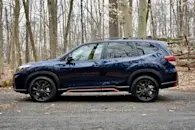





The 2020 Volkswagen Tiguan was equipped with VW’s famed turbocharged 2.0-liter four-cylinder engine, creating 184 horsepower and 221 pound-feet of torque. Potential buyers could choose between front-wheel drive or all-wheel drive versions. The Tiguan’s significant curb weight, ranging from 3,757 pounds for the front-wheel-drive version to as much as 3,847 pounds for the AWD version, demanded this high torque to achieve a satisfactory performance. However, the Tiguan didn't exactly excel in terms of outright speed or nimbleness. The eight-speed automatic transmission offered smooth downshifts and snappy throttle responses, but fully loaded highway passes could be a test of patience.
Noise insulation worked well too—engine noise was refined, and wind noise was kept to a minimum, although rough road surfaces let a bit of noise trickle through. The Tiguan’s larger wheelbase did slightly hinder its nimbleness, and its softer suspension provided a comfortable albeit unexciting driving experience. For those seeking more driving fun, other compact crossovers, like the Mazda CX-5, were better choices.
Meanwhile, the 2021 Subaru Forester's single powertrain—a 2.5-liter boxer four-cylinder engine—produced 182 horsepower and 176 pound-feet of torque. This engine was paired to a continuously variable automatic transmission (CVT). The Forester's engine felt adequate for most driving situations but fell short during overtaking and highway merging. Additionally, wind noise at highway speeds was noticeable, adding a layer of discomfort to long drives.
The Forester's suspension was tuned for comfort rather than handling, resulting in a ride that was softer but somewhat less controlled. The vehicle showed considerable body roll in corners and bounced over uneven surfaces. However, Forester’s forte was off-road driving, thanks to its standard AWD and 8.7 inches of ground clearance. Subaru's X-Mode, included in Sport models, provided "Snow/Dirt" and "Snow/Mud" settings for various terrains. Hill-descent control was standard on the Premium and higher trims.
The interior space and functionality of the Tiguan highlighted Volkswagen's commitment to practicality. The second-row seats could slide up to seven inches to provide reasonable legroom in the third row. Though the third-row space wasn't vast, it could accommodate shorter adults and kids, especially useful for families. Access to this row was facile with simple latch mechanisms.
With the third-row folded, the cargo capacity of the Tiguan expanded to 65.7 cubic feet, and the figure for the two-row version stood at an impressive 73.5 cubic feet. This outdid competitors like the Ford Escape and Toyota RAV4 but slightly lagged behind the Honda CR-V’s 75.8 cubic feet.
The Subaru Forester, built for five passengers, stood out for its generous headroom and legroom in both rows, enhanced by a tall roofline. This roof provided excellent outward visibility and contributed to a spacious feel. The cargo space in the Forester was substantial as well—35.4 cubic feet with rear seats up and 76.1 cubic feet with them folded down. However, the lack of a sliding second-row bench was a downer, a feature present in competitors like the Ford Escape and Nissan Rogue.
The Forester’s cupholders were decently sized without encroaching on space, but limitations existed in phone storage, and wireless charging was not available. The power-adjustable driver’s seat was not included in the base model, requiring purchasers to look at higher trims for such conveniences.
Volkswagen’s MIB II infotainment system in the 2020 Tiguan was highly regarded, even with the impending upgrade to MIB3 in 2021. The base S trim came with a 6.5-inch touchscreen, which was industry-standard, but the 8-inch capacitive touchscreen available in higher trims set a high bar. Its glass surface, vivid colors, and speedy response made it a joy to use. The Tiguan S featured a single USB-C port in the front, while the upper trims opted for traditional USB-A ports both in the front and back. Wireless charging was an added perk in the higher trims.
An example of next-level technology was VW’s Digital Cockpit found in the SEL trim. This fully digital and customizable instrument panel could display a panoramic map, keeping VW ahead in technology while still supporting Apple CarPlay and Android Auto.
The 2021 Subaru Forester came with the Starlink infotainment system, featuring a 6.5-inch touchscreen, Apple CarPlay, and Android Auto as standard. Sport models upgraded to an 8-inch touchscreen coupled with a Harman Kardon audio system. Navigation and additional USB ports for the rear were included in the Limited and Touring models. The Forester’s system was user-friendly, featuring analog controls for major functions, but the screen's slow startup could be a disappointment.
Subaru also included a secondary screen for supplemental information like fuel economy and tire pressure. While this could be helpful, having multiple screens showing similar data might appear redundant to some users.
The 2020 Volkswagen Tiguan's safety suite saw significant enhancements, with features like forward-collision warning, automatic emergency braking, blind spot monitoring, and rear cross-traffic alert becoming standard across all trims. However, adaptive cruise control with lane-keeping assistance was only available in the top SEL trim, a notable limitation when compared to rivals like the Honda CR-V and Toyota RAV4, which included adaptive cruise systems in their base models. The Tiguan also featured VW’s Car-Net, a telematics package that connected the vehicle to an owner's smartphone, enabling remote access functions including vehicle status checks and geofencing. The IIHS awarded the Tiguan a Top Safety Pick, but only for the SEL Premium models equipped with LED headlights as most trims had halogen headlights rated poor by IIHS.
Safety was a recognized strength for Subaru, and the 2021 Forester epitomized this. It received a "Top Safety Pick+" award from the IIHS, indicating top ratings across all crash tests and superior front-crash prevention tech. The NHTSA also gave it a five-star overall rating. The Forester came standard with Subaru's EyeSight driver-assist suite, which included adaptive cruise control, automatic emergency braking, lane-departure warning, and lead-vehicle start alert. Unique to Subaru, the DriverFocus system monitored driver distraction using a camera, adding another layer of safety. Features like blind-spot monitoring and reverse automatic braking were available as options, while the adaptive cruise control performed adequately, ensuring drivers were attentive.
CarGurus highlights

According to CarGurus experts, the overall rating for the 2020 Volkswagen Tiguan was 7.7 out of 10, while the 2021 Subaru Forester scored 7.5 out of 10. Both SUVs have their distinctive strengths and areas of appeal. The Tiguan excelled in delivering advanced technology and superior cargo flexibility. It also offered a third-row option, adding to its versatility. Conversely, the Forester shone brightly in the safety department, was a reliable companion off-road, and provided a no-nonsense, functional cabin ideal for active lifestyles. Yet, when it comes to making a final choice, based on the higher overall rating, the 2020 Volkswagen Tiguan emerges as the recommended option. Its balance of cargo capacity, tech-savvy features, and comfort in highway driving make it a compelling choice in the compact crossover segment.
Choose the 2021 Subaru Forester if:
- Superior safety ratings and a comprehensive suite of standard driver-assist features are critical to your decision.
- You often drive on varied terrains and require a car with excellent off-road capabilities and standard AWD.
- Practicality and durability in interior materials complementing an overall functional design appeal to you.
Choose the 2020 Volkswagen Tiguan if:
- You prioritize cargo space and require a third-row seat option for additional passenger capacity.
- Technological sophistication with features like the Digital Cockpit and an intuitive infotainment system is important to you.
- You seek a vehicle with refined and quiet driving dynamics for highway journeys.
CarGurus highlights

According to CarGurus experts, the overall rating for the 2020 Volkswagen Tiguan was 7.7 out of 10, while the 2021 Subaru Forester scored 7.5 out of 10. Both SUVs have their distinctive strengths and areas of appeal. The Tiguan excelled in delivering advanced technology and superior cargo flexibility. It also offered a third-row option, adding to its versatility. Conversely, the Forester shone brightly in the safety department, was a reliable companion off-road, and provided a no-nonsense, functional cabin ideal for active lifestyles. Yet, when it comes to making a final choice, based on the higher overall rating, the 2020 Volkswagen Tiguan emerges as the recommended option. Its balance of cargo capacity, tech-savvy features, and comfort in highway driving make it a compelling choice in the compact crossover segment.
Choose the 2021 Subaru Forester if:
Shop Now- Superior safety ratings and a comprehensive suite of standard driver-assist features are critical to your decision.
- You often drive on varied terrains and require a car with excellent off-road capabilities and standard AWD.
- Practicality and durability in interior materials complementing an overall functional design appeal to you.
Choose the 2020 Volkswagen Tiguan if:
Shop Now- You prioritize cargo space and require a third-row seat option for additional passenger capacity.
- Technological sophistication with features like the Digital Cockpit and an intuitive infotainment system is important to you.
- You seek a vehicle with refined and quiet driving dynamics for highway journeys.

By: CarGurus + AI
At CarGurus, our team of experienced automotive writers remain at the heart of our content operation, conducting hands-on car tests and writing insightful guides that are backed by years of industry experience. To complement this, we are harnessing AI to make our content offering more diverse and more helpful to shoppers than ever. To achieve this, our AI systems are based exclusively on CarGurus content, ratings and data, so that what we produce is both unique to CarGurus, and uniquely helpful to car shoppers.
